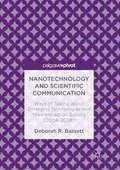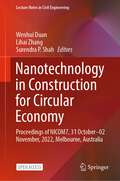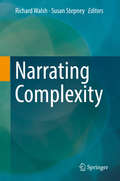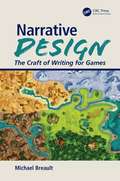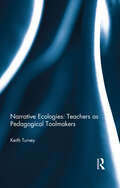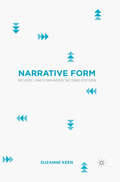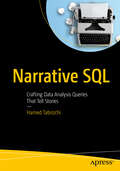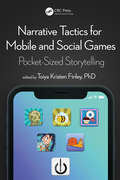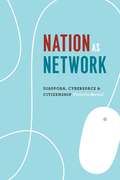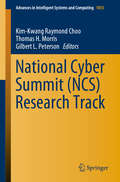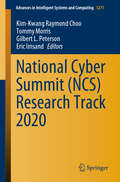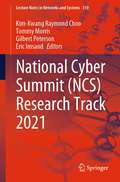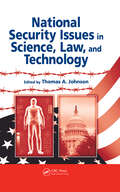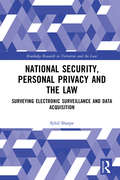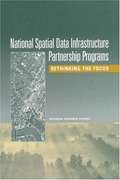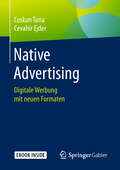- Table View
- List View
Nanotechnology and Scientific Communication: Ways of Talking about Emerging Technologies and Their Impact on Society (2004-2008)
by Deborah R. BassettThis study examines findings from a 4-year-long ethnography of communication among a research university’s community of scientists and engineers working in nanoscience and nanotechnology. It includes analysis of 20 in-depth interviews with scientists and engineers from 18 different disciplines self-identified as working in nanoscale science and engineering. Using multiple methods of inquiry, including fieldwork, interviews, and textual analysis, elements of a shared speech code are presented, each of which indicate culturally distinctive understandings of psychology, sociology and rhetoric. In particular, the interview data addresses questions such as “What kind of person is a scientist?” “What is the role of science in society?” and “What is the role of communication in science?” This book will appeal to readers interested in science and society, scientific communication, and ethnography of communication.
Nanotechnology in Construction for Circular Economy: Proceedings of NICOM7, 31 October–02 November, 2022, Melbourne, Australia (Lecture Notes in Civil Engineering #356)
by Surendra P. Shah Lihai Zhang Wenhui DuanThis open access book covers emerging opportunities and future use of nanotechnology in construction, including deep advances in cement chemistry, nanotechnology, artificial intelligence, robotics, concrete technology, and extreme engineering (blast, impact and fire). The proceedings also presents sectorial interactions within the traditional construction industry supply chain, enabled by the dynamic partnership between international industry, government agencies, and universities. Nanotechnology has transformed the construction materials industry into an advanced manufacturing sector to address climate change and carbon neutrality challenges by delivering sustainable and resilient infrastructure assets. Hence, this book reports specific advances in nanoscience and nano-engineering, and their impacts on numerous novel construction materials including binders, additives, high-performance concrete materials, concrete structural systems, polymer composites, and pavement materials.
Narrating Complexity
by Richard Walsh Susan StepneyThis book stages a dialogue between international researchers from the broad fields of complexity science and narrative studies. It presents an edited collection of chapters on aspects of how narrative theory from the humanities may be exploited to understand, explain, describe, and communicate aspects of complex systems, such as their emergent properties, feedbacks, and downwards causation; and how ideas from complexity science can inform narrative theory, and help explain, understand, and construct new, more complex models of narrative as a cognitive faculty and as a pervasive cultural form in new and old media. The book is suitable for academics, practitioners, and professionals, and postgraduates in complex systems, narrative theory, literary and film studies, new media and game studies, and science communication.
Narrative Design for Mobile and Live Games
by Valentina TamerThis is a comprehensive guidebook for long-term storytelling in mobile games and games-as-a-service (also known as live games). This book formalizes creative techniques of game writing and narrative design for a platform (and revenue model) that has shown drastic growth and changes over the past few years. The unique challenges of mobile games and live games are also increasingly relevant across the whole games industry. With hybrid consoles such as the Nintendo Switch, cloud gaming, and cross-platform titles, the lines between mobile and console have begun to blur. Additionally, many games now offer live support to extend player engagement. This book starts with an introduction to narrative design and the world of mobile games, followed by a deep dive into open-ended and seasonal storytelling. Besides the creative aspect of development, it covers areas of production such as documentation, collaboration, and monetization. To illustrate its solutions, it uses examples from video games and other media, specifically screenwriting for TV shows. This book will be of great interest to all game narrative and writing professionals working on mobile and live games.
Narrative Design: The Craft of Writing for Games
by Michael BreaultNarrative designers and game designers are critical to the development of digital and analog games. This book provides a detailed look at the work writers and designers perform every day on game development projects. It includes practical advice on how to break into the game industry as a writer or game designer. Readers can use the templates and detailed instructions provided here to create lively portfolios that will help open the door to jobs in the game industry. Key features of this book: • An intimate look at the workings of AAA game development from someone who has spent decades embedded on teams at well-known companies. • An insider’s look at the game industry, including advice on breaking into the industry. • Detailed instructions for creating a portfolio to demonstrate narrative design and game design skills to prospective employers. • Lessons and exercises to help students develop narrative design and game design skills. • A how-to guide for college instructors teaching classes in narrative design and game design. Detailed assignments and syllabi are included. Author Bio: Michael Breault is a 35-year industry veteran who has contributed his writing and game design skills to over 130 published games. He currently teaches narrative design and game design courses at Webster University in St. Louis. The courses he creates and teaches are based on the tasks narrative designers and game designers undertake every day while developing games. These classes provide his students with a real-world view of the work they will be doing as writers and designers in the game industry.
Narrative Ecologies: Teachers As Pedagogical Toolmakers
by Keith TurveyIn recent years there has been significant investment by policy makers in the potential of technological tools to transform learning and teaching across a range of professional practitioner groups; education, nursing and social care. There remain, however, outstanding issues concerning the ways educators and professional practitioners harness the p
Narrative Form: Revised and Expanded Second Edition
by Suzanne KeenThis revised and expanded handbook concisely introduces narrative form to advanced students of fiction and creative writing, with refreshed references and new discussions of cognitive approaches to narrative, nonfiction, and narrative emotions.
Narrative SQL: Crafting Data Analysis Queries That Tell Stories
by Hamed TabrizchiThis book addresses an important gap in data analytics education: the interplay between complex query-making and storytelling. While many resources cover the fundamentals of SQL queries and the technical skills required to manipulate data, few also explore moving beyond the numbers and figures to tell stories that drive strategic business decisions. By weaving together both SQL and narrative mechanics, author Hamed Tabrizchi has assembled a powerful tool for data analysts, aspiring database professionals, and business intelligence specialists. A strong foundation is laid in the first part of the book, which examines the technical skills necessary to access and manipulate data. You&’ll explore foundational SQL commands, advanced querying techniques, data manipulation, data integrity, and optimization of queries for performance. The second half moves from the "how" of SQL to the "why," examining the meaning-making practices we can apply to data, and the stories data can tell. You'll learn how SQL queries can be interpreted, how to prepare data for visualization, and most importantly, how to convey the findings in a way that engages and informs the audience. In each chapter, practical exercises reinforce the techniques learned and help you apply them in real-world situations. In addition to strengthening technical skills, these exercises encourage readers to take a critical view of the data they are studying, considering the larger story it represents. Upon completing this book, you will not only be proficient in SQL, but also possess the key skill of converting data into narratives that can influence strategic direction and operational decisions in the modern workplace. What You Will Learn Advanced SQL Techniques: Master data manipulation and retrieval skills using advanced SQL queries Data Analysis Proficiency: Develop analytical skills to uncover key insights and understand significant data patterns Storytelling with Data: Learn to translate data analytics into compelling narratives for effective stakeholder communication Complex Querying Skills: Understand advanced SQL concepts such as common table expressions (CTEs), subqueries, and window functions Query Optimization: Optimize query execution time, resource usage, and scalability by mastering Indexes and Views Practical Application of Techniques: Gain hands-on experience with practical examples of advanced SQL techniques in real-world data analysis scenarios Effective Data Presentation: Discover strategies for visually presenting data stories to enhance engagement and understanding among diverse audiences Who This Book Is For Data analysts and business analysts, SQL developers, data-driven managers and executives and academics and students looking to enhance advanced querying and narrative building skills to better interpret and convey data.
Narrative Tactics for Mobile and Social Games: Pocket-Sized Storytelling
by Toiya Kristen FinleyDespite its significant growth over the past five years, the mobile and social videogame industry is still maturing at a rapid rate. Due to various storage and visual and sound asset restrictions, mobile and social gaming must have innovative storytelling techniques. Narrative Tactics grants readers practical advice for improving narrative design and game writing for mobile and social games, and helps them rise to the challenge of mobile game storytelling. The first half of the book covers general storytelling techniques, including worldbuilding, character design, dialogue, and quests. In the second half, leading experts in the field explore various genres and types of mobile and social games, including educational games, licensed IP, games for specific demographics, branding games, and free to play (F2P). <P><P>Key Features <li>The only book dedicated to narrative design and game writing in social and mobile games, an explosive market overtaking the console gaming market. <li>Provides tips for narrative design and writing tailored specifically for mobile and social game markets. <li>Guides readers along with conclusions that include questions to help the reader in narrative design and/or writing. <li>Explores real games to illustrate theory and best practices with analyses of game case studies per chapter, covering indie, social/mobile, and AAA games. <li>Includes checklists to help readers critique their own narrative design/writing.
Narrative as Virtual Reality 2: Revisiting Immersion and Interactivity in Literature and Electronic Media
by Marie-Laure RyanRethinking textuality, mimesis, and the cognitive processing of texts in light of new modes of artistic world construction.Winner of the Aldo and Jeanne Scaglione Prize for Comparative Literary Studies from the Modern Language Association of AmericaIs there a significant difference between engagement with a game and engagement with a movie or novel? Can interactivity contribute to immersion, or is there a trade-off between the immersive "world" aspect of texts and their interactive "game" dimension? As Marie-Laure Ryan demonstrates in Narrative as Virtual Reality 2, the questions raised by the new interactive technologies have their precursors and echoes in pre-electronic literary and artistic traditions. Approaching the idea of virtual reality as a metaphor for total art, Ryan applies the concepts of immersion and interactivity to develop a phenomenology of narrative experience that encompasses reading, watching, and playing. The book weighs traditional literary narratives against the new textual genres made possible by the electronic revolution of the past thirty years, including hypertext, electronic poetry, interactive drama, digital installation art, computer games, and multi-user online worlds like Second Life and World of Warcraft.In this completely revised edition, Ryan reflects on the developments that have taken place over the past fifteen years in terms of both theory and practice and focuses on the increase of narrativity in video games and its corresponding loss in experimental digital literature. Following the cognitive approaches that have rehabilitated immersion as the product of fundamental processes of world-construction and mental simulation, she details the many forms that interactivity has taken—or hopes to take—in digital texts, from determining the presentation of signs to affecting the level of story.
Narrowband Single Photons for Light-Matter Interfaces (Springer Theses)
by Markus RambachThis book provides a step-by-step guide on how to construct a narrowband single photon source for the integration with atom-based memory systems. It combines the necessary theoretical background with crucial experimental methods and characterisations to form a complete handbook for readers at all academic levels. The future implementation of large quantum networks will require the hybridisation of photonic qubits for communication with quantum memories in the context of information storage. Such an interface requires carefully tailored single photons to ensure compatibility with the chosen memory. The source itself is remarkable for a number of reasons, including being the spectrally narrowest and brightest source of its kind; in addition, it offers a novel technique for frequency stabilisation in an optical cavity, together with exceptional portability. Starting with a thorough analysis of the current literature, this book derives the essential parameters needed to design the source, describes its individual components in detail, and closes with the characterisation of a single photon source.
Nation as Network: Diaspora, Cyberspace, and Citizenship
by Victoria BernalHow is the internet transforming the relationships between citizens and states? What happens to politics when international migration is coupled with digital media, making it easy for people to be politically active in a nation from outside its borders? In Nation as Network, Victoria Bernal creatively combines media studies, ethnography, and African studies to explore this new political paradigm through a striking analysis of how Eritreans in diaspora have used the internet to shape the course of Eritrean history. Bernal argues that Benedict Anderson’s famous concept of nations as "imagined communities” must now be rethought because diasporas and information technologies have transformed the ways nations are sustained and challenged. She traces the development of Eritrean diaspora websites over two turbulent decades that saw the Eritrean state grow ever more tyrannical. Through Eritreans’ own words in posts and debates, she reveals how new subjectivities are formed and political action is galvanized online. She suggests that "infopolitics”--struggles over the management of information--make politics in the 21st century distinct, and she analyzes the innovative ways Eritreans deploy the internet to support and subvert state power. Nation as Network is a unique and compelling work that advances our understanding of the political significance of digital media.
National 4 & 5 Administration and IT
by Adam Stephenson Anne BradleyBuilds on the outcomes and experiences at Level 4 and provides full coverage of the National 4 & 5 course. This title is endorsed by SQA.- Covers all of the requirements of the Unit Outcomes- Contains practice tasks to allow students to prepare for the National 4 Added Value Unit/National 5 Assignment- Written by respected authors in the Business Education community
National 5 Computing Science, Second Edition
by John Walsh Jane PatersonExam Board: SQALevel: National 5 Subject: Computing ScienceFirst Teaching: August 2017First Exam: June 2018National 5 Computing Science provides complete coverage of the new SQA syllabus for the updated National 5 course Ensures clear support throughout the course with a text built specifically around the requirements, teaching approaches and syllabus outlines. Divided into four sections to follow this latest syllabus: Software Design and Development, Computer Systems, Database Design and Development and Web Design and Development.Assesses student progress with regular questions for National 5 students to test knowledge and understandingConsolidates knowledge with a summary of key points at the end of each chapterIncludes a glossary and index for ease of reference
National 5 Computing Science: Second Edition
by John Walsh Jane PatersonExam Board: SQALevel: National 5 Subject: Computing ScienceFirst Teaching: August 2017First Exam: June 2018National 5 Computing Science provides complete coverage of the new SQA syllabus for the updated National 5 course Ensures clear support throughout the course with a text built specifically around the requirements, teaching approaches and syllabus outlines. Divided into four sections to follow this latest syllabus: Software Design and Development, Computer Systems, Database Design and Development and Web Design and Development.Assesses student progress with regular questions for National 5 students to test knowledge and understandingConsolidates knowledge with a summary of key points at the end of each chapterIncludes a glossary and index for ease of reference
National Cyber Summit (Advances in Intelligent Systems and Computing #1055)
by Kim-Kwang Raymond Choo Thomas H. Morris Gilbert L. PetersonThese proceedings gather papers presented at the Cyber Security Education Stream and Cyber Security Technology Stream of The National Cyber Summit’s Research Track, and report on the latest advances in areas ranging from software security to cyber attack detection and modeling; the use of machine learning in cyber security; legislation and policy; surveying small businesses; cyber competition, and so on. Understanding the latest capabilities in cyber security is the best way to prepare users and organizations for potential negative events. Consequently, this book will be of interest to cyber security researchers, educators and practitioners, as well as students who want to learn about cyber security.
National Cyber Summit (Advances in Intelligent Systems and Computing #1271)
by Kim-Kwang Raymond Choo Gilbert L. Peterson Tommy Morris Eric ImsandThis book presents findings from the papers accepted at the Cyber Security Education Stream and Cyber Security Technology Stream of The National Cyber Summit’s Research Track, reporting on the latest advances on topics ranging from software security to cyber attack detection and modelling to the use of machine learning in cyber security to legislation and policy to surveying of small businesses to cyber competition, and so on. Understanding the latest capabilities in cyber security ensures that users and organizations are best prepared for potential negative events. This book is of interest to cyber security researchers, educators, and practitioners, as well as students seeking to learn about cyber security.
National Cyber Summit (Lecture Notes in Networks and Systems #310)
by Kim-Kwang Raymond Choo Gilbert Peterson Tommy Morris Eric ImsandThis book presents findings from the papers accepted at the Cyber Security Education Stream and Cyber Security Technology Stream of The National Cyber Summit’s Research Track, reporting on latest advances on topics ranging from software security to cyber-attack detection and modelling to the use of machine learning in cyber security to legislation and policy to surveying of small businesses to cyber competition, and so on. Understanding the latest capabilities in cyber security ensures users and organizations are best prepared for potential negative events. This book is of interest to cyber security researchers, educators and practitioners, as well as students seeking to learn about cyber security.
National Security Issues in Science, Law, and Technology
by Thomas A. JohnsonUsing the best scientific decision-making practices, this book introduces the concept of risk management and its application in the structure of national security decisions. It examines the acquisition and utilization of all-source intelligence and addresses reaction and prevention strategies applicable to chemical, biological, and nuclear weapons; agricultural terrorism; cyberterrorism; and other potential threats to our critical infrastructure. It discusses legal issues and illustrates the dispassionate analysis of our intelligence, law enforcement, and military operations and actions. The book also considers the redirection of our national research and laboratory system to investigate weapons we have yet to confront.
National Security Research on the Internet
by William M. ArkinGuide to research on the internet on national security issues.
National Security, Personal Privacy and the Law: Surveying Electronic Surveillance and Data Acquisition (Routledge Research in Terrorism and the Law)
by Sybil SharpeThere have been significant changes in public attitudes towards surveillance in the last few years as a consequence of the Snowden disclosures and the Cambridge Analytica scandal. This book re-evaluates competing arguments between national security and personal privacy. The increased assimilation between the investigatory powers of the intelligence services and the police and revelations of unauthorised surveillance have resulted in increased demands for transparency in information gathering and for greater control of personal data. Recent legal reforms have attempted to limit the risks to freedom of association and expression associated with electronic surveillance. This book looks at the background to recent reforms and explains how courts and the legislature are attempting to effect a balance between security and personal liberty within a social contract. It asks what drives public concern when other aspects seem to be less contentious. In view of our apparent willingness to post on social media and engage in online commerce, it considers if we are truly consenting to a loss of privacy and how this reconciles with concerns about state surveillance.
National Spatial Data Infrastructure Partnership Programs: Rethinking the Focus
by National Research CouncilThe National Academies Press (NAP)--publisher for the National Academies--publishes more than 200 books a year offering the most authoritative views, definitive information, and groundbreaking recommendations on a wide range of topics in science, engineering, and health. Our books are unique in that they are authored by the nation's leading experts in every scientific field.
Native Ads
by Brian GravesBasically, what we are doing in this special method is that we send cheap traffic to simple domains we own that have sponsored ads on them. How do we get the ads on the domains? We simply park the domain with a provider that will put the ads on our domain automatically.
Native Advertising: Digitale Werbung Mit Nativen Kampagnen
by Coskun Tuna Cevahir EjderDieses Buch erklärt kompakt und auf den Punkt, was Native Advertising ist, wie diese neue Werbedisziplin funktioniert und welche Vorteile sie Werbungtreibenden bietet. Die Autoren – selber Vorreiter in dieser jungen Branche – geben einen aktuellen Überblick mit wichtigen Daten und Fakten, erklären alle nativen Werbeformate im Detail und beschreiben die Technologien sowie die durchaus kontrovers diskutierten Rollen der einzelnen Player dabei: Publisher, Advertiser und Konsumenten.Ein Praxisleitfaden für alle, die an Online-Werbung jenseits von Bannern und Rectangles interessiert sind, um ihren Produkten mit sensibel gestalteten und gut ausgesteuerten nativen Kampagnen mehr Glaubwürdigkeit und Sympathie zu verleihen.
Native Advertising: The Essential Guide
by Dale LovellNative advertising: paid-for media that looks and behaves like the content around it. It affects us all. If you own a smartphone, use social media or read content online, you will have been exposed to it - often without realizing. Influenced by digital trends such as mobile advertising, programmatic advertising, ad-blocking, fake news and artificial intelligence, native advertising is a multibillion-dollar industry. It is central to the digital success of many leading brands and companies.This comprehensive study by one of the industry's foremost authorities explores the rise of this exhilarating new channel - its impact on the digital media space, and what marketers and businesses need to know about it. This book explores the future of digital advertising and explains why its growth is inevitable, using real-life examples and interviews from marketing leaders around the world and a range of case studies including The New York Times and The Independent.Native Advertising goes beyond sponsored posts on Facebook, promoted tweets and BuzzFeed branded articles. It looks at the heart of the matter: audience, budget, content and success measurement. It is full of first-hand advice for any marketer wanting to make the most of digital innovation.
